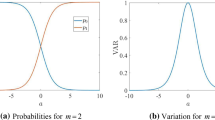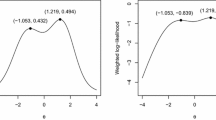Abstract
When a simple sum or number-correct score is used to evaluate the ability of individual testees, then, from an accountability perspective, the inferences based on the sum score should be the same as the inferences based on the complete response pattern. This requirement is fulfilled if the sum score is a sufficient statistic for the parameter of a unidimensional model. However, the models for which this holds true are known to be restrictive. It is shown that the less restrictive nonparametric models could result in an ordering of persons that is different from an ordering based on the sum score. To arrive at a fair evaluation of ability with a simple number-correct score, ordinal sufficiency is defined as a minimum condition for scoring. The monotone homogeneity model, together with the property of ordinal sufficiency of the sum score, is introduced as the nonparametric Rasch model. A basic outline for testable hypotheses about ordinal sufficiency, as well as illustrations with real data, is provided.







Similar content being viewed by others
Notes
This function computes the classical KS-test for continuous distributions, and therefore, does not allow for ties. However, alternative analyses with the ks.boot function from the Matching package (Sekhon, 2011), a function that allows for ties, show similar results.
References
Birnbaum, A. (1968). Some latent trait models and their use in inferring an examinee’s ability. In F. M. Lord & M. R. Novick (Eds.), Statistical theories of mental test scores (pp. 395–479). Reading: Addison-Wesley.
Conover, W. J. (1971). Practical nonparametric statistics. New York: Wiley.
Doob, J. (1949). Heuristic approach to the Kolmogorov–Smirnov theorems. The Annals of Mathematical Statistics, 20, 393–403.
Fischer, G. H. (1974). Einfuhrung in die Theorie psychologischer tests. (Introduction to the theory of psychological tests). Bern: Verlag Hans Huber.
Grayson, D. A. (1988). Two-group classification in latent trait theory: Scores with monotone likelihood ratio. Psychometrika, 53, 383–392.
Guttman, L. (1950). The basis for scalogram analysis. In S. Stouffer, L. Guttman, E. Suchman, P. Lazarsfeld, S. Star, & J. Clausen (Eds.), Measurement and prediction (Vol. 4, pp. 60–90). Princeton, NY: Princeton University Press.
Hemker, B. T., Sijtsma, K., Molenaar, I. W., & Junker, B. W. (1997). Stochastic ordering using the latent trait and the sum score in polytomous IRT models. Psychometrika, 62(3), 331–347.
Hessen, D. J. (2005). Constant latent odds-ratios models and the Mantel–Haenszel null hypothesis. Psychometrika, 70(3), 497–516.
Huynh, H. (1994). A new proof for monotone likelihood ratio for the sum of independent Bernoulli random variables. Psychometrika, 59, 77–79.
Lord, F. M., & Novick, M. R. (1968). Statistical theories of mental test scores. Reading, MA: Addison-Wesley.
Maris, G. (2008). A note on “constant latent odds-ratios models and the Mantel–Haenszel null hypothesis” Hessen, 2005. Psychometrika, 73(1), 153–157.
Meijer, R. R., Sijtsma, K., & Smid, N. G. (1990). Theoretical and empirical comparison of the Mokken and the Rasch approach to IRT. Applied Psychological Measurement, 14(3), 283–298.
Milgrom, P. R. (1981). Good news and bad news: Representation theorems and application. The Bell Journal of Economics, 12(2), 380–391.
Mokken, R. (1971). A theory and procedure of scale analysis. The Hague: Mouton.
Post, W. J. (1992). Nonparametric unfolding models. A latent structure approach. Leiden: DSWO Press.
R Development Core Team (2013). R: A language and environment for statistical computing [Computer software manual]. Vienna, Austria. Retrieved from http://www.R-project.org.
Rasch, G. (1960). Probabilistic models for some intelligence and attainment tests. Copenhagen: The Danish Institute of Educational Research. (Expanded edition, 1980. Chicago: The University of Chicago Press).
Ross, S. M. (1996). Stochastic processes (2nd ed.). New York: Wiley.
Sekhon, J. S. (2011). Multivariate and propensity score matching software with automated balance optimization: The matching package for R. Journal of Statistical Software, 42(7), 1–52.
Sijtsma, K., & Hemker, B. T. (2000). A taxonomy of IRT models for ordering persons and items using simple sum scores. Journal of Educational and Behavioral Statistics, 25(4), 391–415.
Sijtsma, K., & Molenaar, I. (2002). Introduction to nonparametric item response theory. Thousand Oaks, California: Sage Publications Inc.
Verhelst, N. D., & Glas, C. A. W. (1995). The one parameter logistic model: OPLM. In G. H. Fischer & I. W. Molenaar (Eds.), Rasch models: Foundations, recent developments and applications (pp. 215–238). New York: Springer.
Verhelst, N. D., Glas, C. A. W., & Verstralen, H. H. F. M. (1993). OPLM: One parameter logistic model. Computer program and manual. Arnhem: Cito.
Author information
Authors and Affiliations
Corresponding author
Appendix
Appendix
Let n be the number of items in \(\mathbf{z}\), and define
with realizations \(x_+\), \(y_+\) and \(z_+\), respectively.
Following from the partitioning of \(\mathbf{x}_1\) and \(\mathbf{x}_2\),
In cases where
we obtain
Now we consider the posterior distribution
The likelihood ratio can be written as
The natural logarithm of likelihood ratio is
It is generally known that if
then
Now, following from (11), the likelihood ratio can be written as
Rights and permissions
About this article
Cite this article
Zwitser, R.J., Maris, G. Ordering Individuals with Sum Scores: The Introduction of the Nonparametric Rasch Model. Psychometrika 81, 39–59 (2016). https://doi.org/10.1007/s11336-015-9481-x
Received:
Published:
Issue Date:
DOI: https://doi.org/10.1007/s11336-015-9481-x




